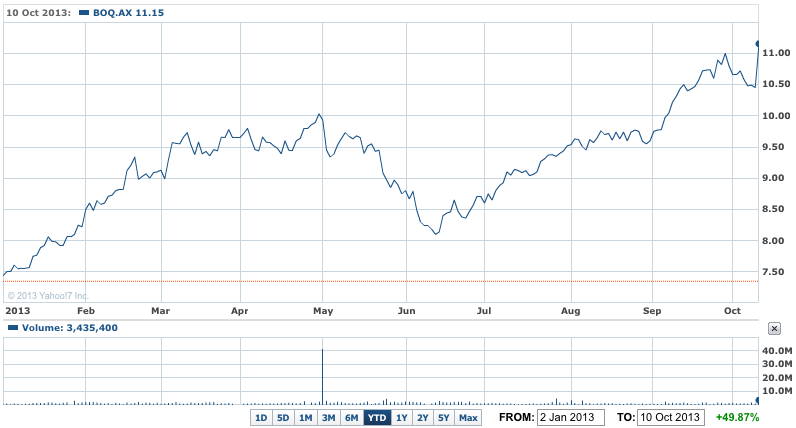The Bank of Queensland (BOQ) has returned to profits for the 2012-13 year, putting behind it the tough 2011-12 when it became the first Australian bank in 20 years to record a loss.
The Brisbane-based bank yesterday revealed a surge in cash profit to $251 million, from the depressed $31 million in the previous year.
Dividend was boosted and the shares jumped 7% or 70c, to end at $11.15.
The statutory profit of $186 million (which includes one off items), was up from the $17 million loss for 2011-12, which was caused by massive write-downs and losses taken on dud property loans in Queensland by the bank’s new CEO and management.
That CEO Stuart Grimshaw said yesterday that since the clean out, the bank had focused on building up the quality of its mortgage portfolio.
"In a low credit growth environment where some players are aggressively chasing mortgage business, we chose to focus on credit quality and margins. We are focused on attracting great customers and, in particular, pursuing higher-margin, higher-return business lending," he said.
But Mr Grimshaw warned that the sluggish economy did mean trading conditions were likely to remain challenging for the next 12 months, especially for small businesses and the retail sector, while the still high value of the Australian dollar would also continue to impact the bank due to its effect on Queensland’s tourism sector.
Mr Grimshaw said the bank was looking to an expected improvement in Queensland’s housing market to offset the weak conditions in other sectors.
Underlying profit before tax was up 8% to $477.4 million as a result of what the bank called "a disciplined approach to asset and margin growth in a low credit growth environment, as well as tight cost control".
BOQ’s strong financial performance saw the Board declare a final dividend of 30c a share fully franked, taking the full year dividend to 58c per share, an increase of 12% on the previous year.
BOQ YTD – Bank of Qld shares up on better result, higher dividend

There were a number of takeaways from the BOQ result for the reports later this month and in early November from the ANZ (Oct. 29), NAB (Oct.31) and Westpac (Nov.4). The Commonwealth releases its first quarter trading update on November 6.
The first point is don’t get excited by the BOQ result – it’s a recovery from the previous year’s bout of house cleaning.
And we have already seen how well the banks are travelling from the CBA’s full year figures and the nine months of updates and results from its three peers.
But the BOQ result does underline the favourable impact of lower impairment provisions (we have already seen those used to boost earnings in the first nine months of the year for the big three and in the full year result for the Commonwealth) and of course lower interest rates.
Credit growth and arrears performance are two other areas to watch for. The Reserve Bank has been telling the banks for two years not to expect rapid lending growth faster than the system is expanding, nor to go chasing growth by lowering lending standards.
After the lax lending standards brought the bank undone in 2011-12, it has tightened its criteria for lending and lending growth slowed, but profits rose.
The RBA has also remarked upon how arrears on home loans, personal loans and credit cards are not at worrying levels at the moment, even though there has been a gentle rise in some areas.
The tougher lending approach and last year’s clean out saw the Bank of Queensland report that its impairment expense fell 71% to $114.6 million ($401.0 million in the 2011-2012 year). Total impaired assets across retail, commercial and BOQ Finance fell 27% to $381.6 million.
"Arrears performance in the retail portfolio continued to improve in line with new collection and recovery procedures, coupled with the benefits of a low interest rate environment. Commercial arrears are improving as the Bank improves its ability to identify and address deteriorating loans earlier, although they still remain high," the bank said.
"In a low credit growth environment, retail lending increased 3% to $26.1 billion (FY12: $25.4 billion) while commercial lending increased 2% to $5.3 billion (FY12: $5.2 billion). Excluding the impact of impaired asset runoff, commercial lending grew at 7.5% or 3.6x system."













